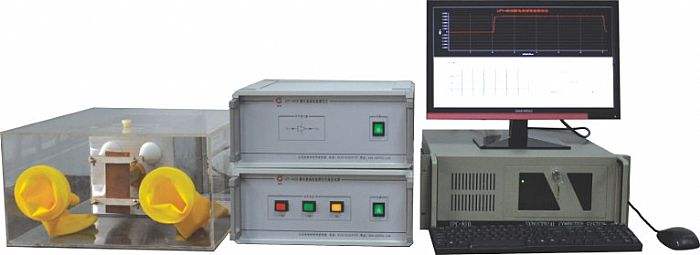What is the static decay test method?
Electrostatic discharge (ESD) is a common risk in the production and use of modern electronic products, potentially damaging delicate electronic components and even causing device failure. Therefore, anti-static testing is crucial to ensure that products and production environments possess sufficient anti-static capabilities to mitigate the risk of static electricity. Electrostatic decay performance is a key quality indicator for products such as anti-static fabrics, packaging materials, and protective equipment for electronic components, and is directly related to the safety and protection provided in electrostatic-sensitive environments. Electrostatic decay testers, specialized instruments for assessing the rate at which static electricity dissipates in materials, are widely used in the electronics, chemical, textile, and medical device industries.
A static honesty meter is an instrument designed to measure static decay and is ideal for measuring the static diffusivity of materials. This device uses air ions generated by corona discharge to stimulate a sample, causing it to charge. After charge deposition, the static decay curve is measured. Because air ions are generated through AC corona discharge, the sample under test can be filled with either positive or negative ions.
The Necessity of Anti-static Testing
The accumulation and sudden release of static electricity can be fatal to electronic devices, especially high-precision integrated circuits and semiconductors. Anti-static testing ensures that protective measures in production environments, such as anti-static materials and equipment, effectively prevent the accumulation and release of static electricity. Rigorous anti-static testing prevents potential damage to products, reduces unnecessary repair and replacement costs, and ultimately improves product quality and reliability.
Common Anti-static Testing Methods
1. Surface Resistivity Test
Surface resistance is a key indicator for evaluating anti-static materials. It measures the ability of a material's surface to resist the passage of electric current. A high surface resistance indicates that the material effectively prevents charge accumulation.
Testing Steps:
- Using a surface resistance tester, place two electrodes on the surface of the material.
- Apply a known voltage between the electrodes, measure the current, and calculate the surface resistance.
- Instrument Requirement: Typically, a Keithley surface resistance tester is used.
Note: Avoid high humidity during testing, as humidity may affect the material's resistance value, resulting in inaccurate test results.
2. Volume Resistivity Test
The volume resistance test is used to evaluate the internal conductivity of a material. Anti-static materials should have a certain volume resistance to prevent charge accumulation.
Testing Steps:
- Using a volume resistance tester, place two electrodes on the top and bottom of the material.
- Apply a voltage between the electrodes, measure the current, and calculate the volume resistance.
Instrument Requirements: Commonly used volume resistivity testers such as the Trek 1500.
Note: Volume resistivity testing has strict requirements for material thickness, so ensure uniform material thickness during testing.
3. Static Decay Time Test
Static decay time refers to the time it takes for a material to reduce its charge to a safe level after being electrostatically charged. This metric can be used to evaluate the discharge efficiency of anti-static materials.
Test Procedure:
- Apply a high voltage to the material to generate static electricity. Then, the voltage is removed and the time it takes for the material's charge to decay to a specific value is measured.
Instrument Requirements: Static decay testers such as the Decay Timer are suitable for this test.
Note: Ambient temperature and humidity significantly affect decay time, so testing should be performed under standard conditions.
4. Tribovoltage Test
Tribovoltage is the amount of charge accumulated through friction. Anti-static materials should have a low tribovoltage to avoid excessive static electricity generated by friction.
Test Procedure:
- Using a standard tribovoltage tester, rub the material against a specified test surface.
- Measure the voltage accumulated on the material after friction.
Required Instrument: Common equipment such as a tribovoltage test bench.
Note: The friction force and number of friction cycles must strictly comply with standards. Excessive friction may result in distorted test results.
Static Honest Meter Operation Procedure
The Static Honest Meter uses capacitive coupling charging and voltage monitoring to quantitatively evaluate a material's electrostatic decay performance by simulating the static generation and dissipation process in a real-world environment. The specific process is as follows:
First, sample preparation and installation: Cut the sample to be tested into the specified size (e.g., 30cm x 30cm) and lay it flat on the instrument's insulated test platform, ensuring good contact between the sample and the platform without wrinkles or overhanging areas.
Second, the electrostatic charging phase: The instrument uses a high-voltage electrode to capacitively charge the sample, bringing the sample surface to a set initial voltage (e.g., 1000V). During the charging process, the charging time and voltage stability must be controlled to prevent overcharging or voltage fluctuations from affecting the test results.
Finally, decay monitoring and recording: After charging is complete, the high-voltage electrode is immediately disconnected and the voltage monitoring system is activated. The instrument uses an electrostatic probe to collect real-time voltage changes on the sample surface and automatically records the time it takes for the voltage to decay from the initial value to 10%. This time is the sample's electrostatic half-life, which is used to determine whether the electrostatic decay performance meets the requirements.
Static Electricity Measurement Precautions
1. Grounding Precautions
For accurate measurement, the measuring instrument must be grounded. This is because static electricity from the human body can affect the measuring instrument. If you are certain that the human body is not charged with static electricity or if measurement accuracy is not required, grounding is not necessary. Measurements are particularly difficult when the person is walking around. For accurate measurement of static electricity from the human body in locations such as semiconductor factories, a grounding wire is essential.
2. When the Voltage of the Target Object is Unknown
When the voltage of the target object is unknown, approach it slowly from a distance. If the upper limit of measurement is exceeded before reaching the specified measurement distance, stop measuring. Otherwise, the sensor may be damaged. Forcibly approaching, even at a distance of 50mm, can cause discharge, resulting in instrument malfunction due to electric shock. If measuring an object with a voltage exceeding the upper limit, you can measure from a distance and perform some calibration while measuring. However, in principle, avoid over-range measurements.
3. Measuring Distance
The DZ4 has a measuring distance of 30mm. The distance can be roughly determined by the focal point of the light. Always pay attention to the light during measurement.
4. Shock
The tuning fork-type sensor in an electrostatic meter is relatively fragile. It is not shock-resistant. Drops from heights, rough placement on a table, or other impacts can cause the sensor to malfunction.
5. Humidity
HONEST METERs, charged flat-panel monitors, DX, and DP, used to measure static decay in high humidity environments, can cause decay and interfere with measurement. In such cases, wait for the environment to dry out or allow the meter to dry. Increasing the temperature can help with drying, but be aware that excessive temperatures can cause instrument malfunction. For charged flat-panel monitors, use warm air to dry the plate's legs (the four white legs) to reduce the effects of humidity.
6. Causes of Measurement Errors
A grounded object near the measured object can disrupt the electric field, resulting in inaccurate measurements. Furthermore, the meter is calibrated using a 200mm square reference tool called a calibration plate. Calibration is required if the measured object's dimensions are outside this range. Large errors are particularly likely to occur when measuring small objects, so please exercise caution when using it. Different measuring instruments have fixed measurement distances, and inaccurate measurement distances can also lead to errors.
Anti-static testing is a key step in ensuring the safety and reliability of electronic products. Whether it's surface resistivity, volume resistivity, static decay time, or tribovoltage testing, all can effectively evaluate the anti-static performance of materials or devices. By adhering to relevant standards, companies can ensure their products meet industry requirements and avoid quality issues caused by static electricity. In the rapidly developing modern electronics industry, the importance of anti-static testing is self-evident. From the precise implementation of various anti-static testing methods, to the meticulous and rigorous operating procedures of static decay testers, to the strict adherence to numerous precautions during the static measurement process, every step is closely linked to the ultimate anti-static performance of electronic products. Only by conducting comprehensive and high-standard anti-static testing can we provide a solid safety barrier for electronic products, ensuring stable operation in complex and changing environments, and ultimately driving the entire electronics industry towards higher quality and greater reliability.


